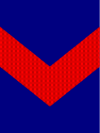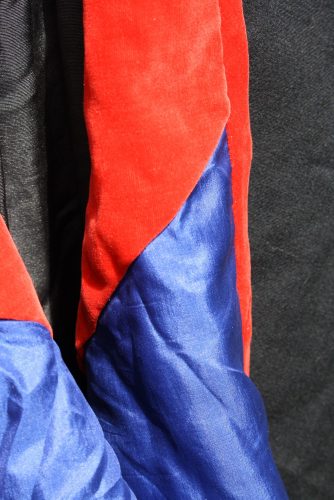Princeton Theological Seminary
New Jersey
1812


VELVET CHEVRON
The history of Princeton Theological Seminary’s blue and red school colors is not available at this time, but the color shades are dark blue and bright red.
Citations in the World Almanac (listed by cover date; color information is from the previous year): blue/red (1923-1935)

To avoid duplicating the hood lining already assigned to St. Francis College (dark blue with a scarlet chevron), the Intercollegiate Bureau assigned Princeton Theological Seminary a hood lining that was Yale blue with a scarlet velvet chevron no later than 1927, according to an IBAC list from that period. “Yale blue” was how the IBAC described a dark blue shade, whereas “scarlet” described a bright red. This hood lining description did not change in subsequent Intercollegiate Bureau lists. During this period, the Bureau often heraldically interpreted the academic hood as an inverted collegiate shield, so in this case the reversed chevron in the seminary’s shield became a standard chevron in its hood.
A list of hood linings compiled by Kevin Sheard in Academic Heraldry in America (1962) described the seminary’s hood lining as cardinal with a royal blue silk chevron. But in Academic Dress and Insignia of the World (1970) Sheard revised his data in a manner consistent with IBAC lists from that period and described Princeton Theological Seminary’s hood lining as royal blue (dark blue) with a scarlet velvet chevron.


On 16 May 1895 the Intercollegiate Commission on Academic Costume approved a uniform system of caps, gowns, and hoods for American colleges and universities called the “Intercollegiate Code of Academic Costume”. The commissioners intended for every college and university to use a unique arrangement of their colors in their hood lining, which would enable an observer to “read” the hood and thereby identify the alma mater of the hood’s owner. The commissioners were initially stymied by the fact that many colleges and universities use the same school colors until Gardner Cotrell Leonard, the Director of the Intercollegiate Bureau of Academic Costume (IBAC) and an advisor to the Commission, suggested that various heraldic divisions of the colors might be employed to create distinctive hood lining patterns that could be individually assigned to each school that chose to follow the Intercollegiate Code.
The chevron was by far the most common heraldic division the IBAC employed to divide the two or three colors in an institution’s hood lining, which was tailored from silk. For greater variety, the Intercollegiate Bureau occasionally used a velvet chevron on a silk hood lining instead of the standard silk chevron that matched the silk lining of the hood. By 1927 a tiny handful of schools sported hoods with velvet chevrons.
